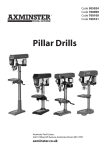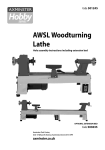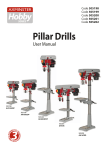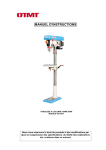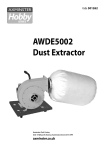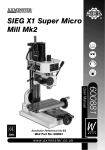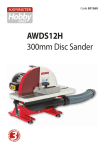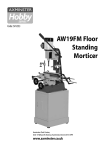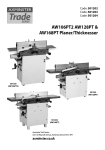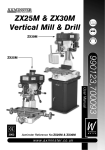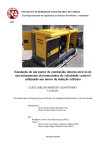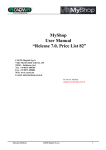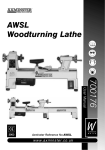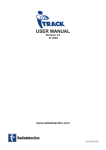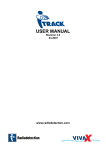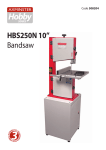Download Axminster WD-20 User manual
Transcript
Axminster Pillar Drills 700091 WD16B Bench Pillar Drill 700100 ED16B2 Bench Pillar Drill User Manual 700090,700091,700092,700099 700100,700101,951645 700092 WD16F Floor Pillar Drill 700101 ED16SB Bench Pillar Drill 700090 WD13S 700099 WD13L Bench Pillar Drills 951645 WD16SB Bench Pillar Drill Axminster Reference No’s: WD16B, WD16F, WD13S, WD13L, ED16B2, WD16SB www.axminster.co.uk W AXMINSTER W H I T E Index of Contents Page No. Index of Contents.............................................................................................................................................. 2 Declaration of Conformity………….………........……..…………................................................................. ..2 What’s in the Box………….………........……..…………..................................................................................... 3 General Safety Instructions Mains Equipment.............................................................................4-5 Initial Assembly Instructions........................................................................................................ 5-6 Specifications….………........……..…………................................................................................................7-8 Identification and Description of the Drill Press................................................................... 9-11-13 Machine Illustration of the Drill Press............................................................................ 10-12-14-15 Changing Speed............................................................................................................................ 16 Speed Select Table........................................................................................................................ 17 General Safety Instructions for Drilling Machines........................................................................ 18 Maintenance................................................................................................................................... 19 Illustrated Parts Beakdown..................................................................................................20-23-25 Illustrated Parts List........................................................................................................ 21-22-24-26 Notes...............................................................................................................................................27 Declaration of Conformity The undersigned, authorised by Laizhou Light Industry Machinery Plant No. 989 Laizhou North Road, Laizhou, Shandong 261400, China declares that this product: Copied from CE Certificate ZQJ4119-3 Drill Press The undersigned, manufactured by Laizhou Light Industry Machinery Plant is in compliance with the following standards or standardisation documents in accordance with Council Directives DIN EN 60204-1:1998-11 Machinery Directive 98/37/EEC, Annex 1 Amended 93/68/EEC authorised by Shandong Laizhou Light Industry Machinery Plant No. 989, North Lai Zhou Road Laizhou, Shandong 261400 P. R. China declares that this product ZQJ4116Q Drill Press manufactured by Shandong Laizhou Light Industry Machinery Plant is in compliance with the following standards or standardisation documents in accordance with Council Directives The undersigned, authorised by Laizhou Plant Machinery Co., Ltd 989 North Lasi Zhou Road Laizhou, Shandong declares that this product: ZQJ4113,ZQJ4119K Drill Press manufactured by Laizhou Plant Machinery Co. is in compliance with the following standards or standardisation documents in accordance with Council Directives 02 EN 55014-1: 1993+A1 EN 61000-3-2: 1995+A13 EN 61000-3-3: 1995 EN 55014-2: 1997 What’s in the Box? Quantity 1 No. 1 No. 1 No. Item Axminster Medium Engineers Drill Press Base Drill Pillar complete with Mounting Flange, Rise and Fall Rack and Rack Retaining Ring Drill Table Mounting Bracket Drill Table Tri- Lever Feed Handle Drill Guard Model Number ZQJ4119-3 ZQJ4113,ZQJ4119K ZQJ4116Q I No. 1 No. 1 No. 1 No. 1 No. Pkt containing:4 No. M10 x 25mm Hexhead Bolts and M10 Spring and Plain Washers 1 No. 6mm Allen Key 1 No. 5mm Allen Key 1 No. 3mm Allen Key 1 No. Pkt containing:1 No. Windlass Handle for Table Rise and Fall Mechanism 1 No. Drill Taper Arbor for the Chuck 1 No. Break Taper Drift 1 No. Box Containing 3-16mm B16 Keyless Chuck 1 No. Box Containing 13mm B16 Keyless Chuck 1 No. Manual 1 No. Guarantee Card Having unpacked your machine and its accessories, please check the contents against the equipment list ”What’s in the box”, if there are any discrepancies, please contact Axminster Power Tool Centre using the procedures laid down in the catalogue. Please dispose of the packaging responsibly; much of the material is bio-degradable. The machine and its accessories will arrive coated with heavy corrosion preventative grease and greased wax paper or plastic wrapping. These will need to be cleaned from the machine, its components and accessories prior to it being set up and commissioned. Use paraffin or a proprietary degreaser to remove the barrier grease. Be warned, it will stain if you splash it on clothing etc.; wear overalls, coverall et al., rubber gloves are also a good idea, as is eye protection if your cleaning process tends to be a little bit enthusiastic. After cleaning, lightly coat the exposed metal surfaces of the machine with a thin layer of light machine oil. N.B If you used paraffin/kerosene make sure you apply this thin film sooner rather than later. Please read the Instruction Manual prior to using your new machine; as well as the installation procedure, there are daily and periodic maintenance recommendations to help you keep your machine on top line and prolong its life. Keep this Instruction Manual readily accessible for any others who may also be required to use the machine. ! 03 General Safety Instructions Mains Equipment Work Place/Environment/Installation Mains Powered Machines Primary Precautions These machines are supplied with a moulded 13 Amp. Plug and 3 core power cable. Before using the machine inspect the cable and the plug to make sure that neither are damaged. If any damage is visible have the machine inspected/repaired by a suitably qualified person. If it is necessary to replace the plug, it is preferable to use an ‘unbreakable’ type that will resist damage. Only use a 13 Amp plug, make sure the cable clamp is tightened securely. Fuse at 13 Amp. If extension leads are to be used, carry out the same safety checks on them, and ensure that they are correctly rated to safely supply the current that is required for your machine. It is also recommended that the power supply outlet is the switched type, and that the supply is switched off whilst plugging in, or unplugging the machine. General Instructions for 240v Tools Good Working Practices/Safety The following suggestions will enable you to observe good working practices, keep yourself and fellow workers safe and maintain your tools and equipment in good working order. ! WARNING!! KEEP TOOLS AND EQUIPMENT OUT OF THE REACH OF YOUNG CHILDREN Work Place/Environment The machine is not designed for sub-aqua operation, do not use when or where it is liable to get wet. If the machine is to be used outside and it starts to rain (unusual though this would be in U.K.), stop work and move it inside. If machine has got wet; dry it off as soon as possible, with a cloth or paper towel. Do not use 240Va.c. powered machines anywhere within a site area that is flooded or puddled, and do not trail extension cables across wet areas. Keep the machine clean; it will enable you to more easily see any damage that may have occurred. Clean the machine with a damp soapy cloth if needs be, do not use any solvents or cleaners, as these may cause damage to any plastic parts or to the electrical components. Keep the work area as uncluttered as is practical, this includes personnel as well as material. ! (Under no circumstances should CHILDREN be allowed in work areas) It is good practice to leave the machine unplugged until work is about to commence, also make sure to unplug the machine when it is not in use, or unattended. Always disconnect by pulling on the plug body and not the cable. Once you are ready to commence work, remove any tools used in the setting operations (if any) and place safely out of the way. Re-connect the machine. Carry out a final check e.g. check the cutting tool, drill bit, saw blade etc., is securely tightened in the machine, check you have the correct speed and function set, check that the power cable will not ‘snag’ etc. Make sure you are comfortable before you start work, balanced, not reaching etc. If the work you are carrying out is liable to generate flying grit, dust or chips, wear the appropriate safety clothing, goggles, gloves, masks etc., If the work operation appears to be excessively noisy, wear ear-defenders. If you wear your hair in a long style, wearing a cap, safety helmet, hairnet, even a sweatband, will minimise the possibility of your hair being caught up in the rotating parts of the machine, likewise, consideration should be given to the removal of rings and wristwatches, if these are liable to be a ‘snag’ hazard. Consideration should also be given to non-slip footwear, etc. 04 General Safety Instructions Mains Equipment (Contiued) DO NOT work with cutting or boring tools of any description if you are tired, your attention is wandering or you are being subjected to distraction. A deep cut, a lost fingertip or worse; is not worth it! DO NOT use this machine within the designated safety areas of flammable liquid stores or in areas where there may be volatile gases. There are very expensive, very specialised machines for working in these areas, THIS IS NOT ONE OF THEM. CHECK that cutters, drills, blades etc., are the correct type and size, are undamaged and are kept clean and sharp, this will maintain their operating performance and lessen the loading on the machine. Above all, OBSERVE…. make sure you know what is happening around you, and USE YOUR COMMON SENSE. Initial Assembly Instructions INITIAL ASSEMBLY FOR: WD16B,WD16F, ED16B2, ED16SB, WD16SB Please read through the section entitled Identification and Description of Parts, so that you will be familiar with the terminology we will use in the manual, so that you can identify the parts quickly and easily and initial assembly will go smoothly. ! WARNING The drillhead is a heavy and substantial piece of machinery, you are advised to have help to lift it clear of the box and fit it to the column. Place the base in a convenient position (on the bench?) and place the mounting flange of the column onto the seating flange of the base. Align the holes. Use the 4 No. M10 x 25mm and the 10mm spring and plain washers and secure the column to the base. Loosen the socket grubscrew holding the cup chamfered retaining collar to the column (with the supplied allen key), remove it and the rise and fall rack, put aside. Take the drill table mounting bracket arm and twist the worm drive shaft with your fingers such that the whole shaft protrudes from the casting and the worm gear itself is clear of the square recess in the main body of the casting. Locate and fit the crank handle to the shaft, ensuring that you tighten the grub screw onto the machined flat on the shaft. This will keep the worm gear in position. Pick up the rise and fall gear rack, identify the top and the bottom, (the rack gearing is cut asymmetrically, with the gear cut extending closer to the bottom), make sure you have the rack the right way up, as it will allow you to drive the drill table up and down over its full range. Fit the rise and fall rack into the square recess in the mounting body casting, ensure that it is engaged with the pinion, and lower the combined mechanism over the column. Allow it to slide down the column until the rise and fall rack is located in the cup chamfer in the top of the mounting flange. Replace the cup chamfered retaining collar over the column and slide it down onto the top of the rack. Lock it in place with the grubscrew, ensuring that it has captured the upper end of the rack securely, but not too tight that the rack can not be swivelled around the pillar. Check that the bracket can be driven up and down the column and can swivel around the pillar. Locate the Bristol clamping handle at the rear of the bracket and tighten, check it has ‘pinched’ up on the column and the bracket is immobile; both in it’s up and down travel and swivel movement. Fit the drill table, identify the Bristol clamping handle at the front of the bracket and tighten, check it has ‘pinched’ up on the drill table spigot and the drill table is immobile. So far so good! Now comes the heavy lift bit. 05 Initial Assembly Instructions (Continued) CHECK the drillhead, ensure that the two hex socket grubscrews that lock the head in place on the column are withdrawn and will not foul on the column when the head is fitted. Put the lower assembly you have just been working on in the most convenient position, make sure it is stable and lift the drillhead over the column and let it drop into place. The column does not ‘come through’ the drillhead, so you don’t have to worry about holding the drillhead in place whilst frantically trying to lock it in place. Set the drill head approximately fore and aft and lock in postion using the two caphead grub screws mentioned earlier. Check that the drillhead is immobile. Everything on the drilling m/c is now secured, and if you now wish to move it to its referred workplace, nothing should slew during the lift and move. Once the drilling machine is correctly positioned and, if necessary, fastened down; you can proceed with the final assembly. Locate the tri-lever feed handle and its securing screw, note the raised boss of the feed mechanism and the spigot next to it. Mount the handle over the boss and ensure the spigot hole in the handle engages the spigot on the mechanism. Secure with the supplied caphead bolt through the hole in the centre of the handle through to the tapped hole in the mounting boss. Take the chuck guard and fit to the lower bearing flange of the quill mounting. Tighten the screw and nut fastening so that the drill guard is securely held in place. Congratulations, one assembled pillar drill! INITIAL ASSEMBLY FOR: WD13S & WD13L Base/Column Assembly Place the base in a convenient position (on the bench?) and place the mounting flange of the column onto the seating flange of the base. Align the holes. Use the 3 No. M8 x 20mm and the 8mm plain washers and secure the column to the base with a 13mm spanner. Table Assembly Locate the table/support assembly and slide it down the column until it rests on the base plate. Insert the locking clamp lever into the treaded hole to the side of the table casting, slide the table up the column to working height and clamp the table in position. Drillhead Assembly CAUTION: The drillhead is heavy, we recommend you seek assistance. Using the 3mm allen key loosen the two grub screws to the right side of the head, lift the drillhead above the column and let it drop into place. The column does not ‘come through’ the drillhead, so you don’t have to worry about holding the drillhead in place whilst frantically trying to lock it in place. Set the drillhead approximately fore and aft and lock in postion using the two caphead grub screws mentioned earlier. Check that the drillhead is immobile. Everything on the drilling m/c is now secured, and if you now wish to move it to its preferred workplace, nothing should slew during the lift and move. Once the drilling machine is correctly positioned and fastened down, it is ready for use. 06 Specifications Model ED16B2 ED16SB WD16SB 700101 Hobby 370W (5) 460-2890rpm 60mm 127mm 315mm 430mm 951645 Hobby 370W (5) 460-2890rpm 60mm 127mm 315mm 430mm Axminster Medium Pillar Drill Rating Motor 240V 50Hz Speed Range (12) Column Diameter Throat Chuck to Table Chuck to Base 700100 Trade 650W 120-2580rpm 80mm 178mm 310mm 510mm Head Turn, Table Turn, Table Swivel Table Tilt Table Size Table Fixing Quill Mandrel Chuck Capacity/type Chuck Travel Machine Lamp (Fixed Integral) 360˚ 45˚-0-45˚ 290 x 290mm Four No ‘T’ Slots MT2 3-16mm Keyless 80mm </= 40W Edison Screw Bulb 450 x 270mm 710 x 350 x 1015mm 82kg Base Size Overall Size L x W x H Weight 360˚ 45˚-0-45˚ 200 x 200mm Four No ‘T’ Slots MT2 16mm Keyless 60mm Not Fitted 360˚ 45˚-0-45˚ 200 x 200mm Four No ‘T’ Slots MT2 16mm Keyless 60mm Not Fitted 340 x 210mm 310 x 520 x 840mm 37kg 340 x 210mm 310 x 520 x 840mm 37kg 07 Specifications Model WD16B WD16F Axminster Medium Pillar Drilll Rating Motor 240V 50Hz Speed Range (12) Column Diameter Throat Chuck to Table Chuck to Base Chuck to Table Chuck to Base Head Turn, Table Turn, Table Swivel Table Tilt Table Size Table Fixing Quill Mandrel Chuck Capacity/type Chuck Travel Machine Lamp (Fixed Integral) 700091 Trade 550W 210-2580rpm 80mm 178mm 310mm 510mm 700092 700090/700099 Trade Hobby 550W 250W 120-2580rpm (5) 600-2500rpm 80mm 46mm 178mm 105mm 680mm WD13S 126mm 1170mm WD13S 280mm WD13L 215mm WD13L 370mm 360˚ 360˚ 45˚-0-45˚ 45˚-0-45˚ 310 x 310mm 160 x 160mm Four No ‘T’ Slots Four No ‘T’ Slots MT2 B16 3-16mm Keyless 13mm Keyless 80mm 50mm </= 40W Edison Not Fitted Screw Bulb 450 x 270mm 290 x180mm 710 x 350 x 1645mm (700090 WD13S) Base Size Overall Size L x W x H Weight 08 360˚ 45˚-0-45˚ 310 x 310mm Four No ‘T’ Slots MT2 3-16mm Keyless 80mm </= 40W Edison Screw Bulb 450 x 270mm 710 x 350 x 1015mm 80kg 88kg WD13S/WD13L 240 x 470 x 600mm (700099 WD13L) 240 x 470 x 735mm 19kg (WD13S) 26kg (WD13L) Identification and Description of the Drill Press Base casting (See fig 1) This is the ‘Stand’ for the drilling m/c . It has a seating flange to the rear, which has 4 No. M10 tapped holes in the face to bolt down the column flange. There are 4 No. 12mm holes in the approximate corners of the base to enable it to be bolted to the bench or the floor depending upon the model you have purchased. There are also 2 No. slots machined in the base to enable the fastening of a machine vice or similar, if a greater working depth is needed than that available above the table. Drill column (See fig 1) This is the ‘pillar’ of the drill, it is an 80mm diameter steel tube 800mm long. The column is fitted into a mounting flange at the lower end. This flange has four holes bored in it to correspond to the four tapped holes in the base casting. The pillar is normally supplied with the rise and fall rack for the drilling table fitted. The rise and fall rack is held in place between the cup chamfer in the mounting flange and a cup chamfered retaining collar that slides over the pillar and is held in position by a locking grubscrew. Drill table mounting bracket (See fig 1) (See fig 1c) (See fig 1d) This is a cast bracket that fits over the column, it has a worm driven pinion that engages with the rise and fall rack and allows the bracket to be driven up and down on the column. The worm is turned by a windlass type crank handle. The rear of the casting is split and has two lugs, one bored thro’ clearance for the locking clamp lever handle, and the other with a corresponding tapped hole to allow the Bristol lever clamping handle to draw the casting together and ‘pinch’ onto the column and lock the bracket in place. Bolted to the front of the bracket is the drill table mounting. This casting has a hole machined through it to accept the spigot of the drilling table. The casting is split similarly to the main casting with a similar clamping lever handle, which ‘pinches’ the casting around the drill table spigot to lock it in position. If the bolt, holding the two parts of the mounting bracket together is loosened, the drill table mounting can be tilted to enable drilling at an angle. There is a graduated scale and a pointer to enable the tilt angle to be read. Retighten the bolt when the desired angle has been set. Drill table (See fig 1) The drill table is a machined casting 288mm square, with a central spigot that fits into the table mounting. The main land of the table is surrounded by a well, so that a recycling coolant system could be fitted. There are 4 radial ‘T’ slots cut into the main land of the table to facilitate the fixing of machine vices or clamps. Drillhead This is the ‘drilling machine’ and the descriptions of its various parts and components are detailed as follows:- Pulley and drive A pressed steel cover hinged on one side and secured with a machine screw Belt Cover on the other. It covers the drive belt train for safety during normal operation. (See fig 2) There is a microswitch fitted between the cover and the lower tray which will prevent the machine running if the cover is not lowered. Pulleys and There are three pulley towers in the drillhead, the drive pulleys fixed to the drive belts motor shaft, the driven pulleys fitted to the quill, and the intermediate ‘jockey’ (See figs 2 a ,b,c) pulleys that connect the ‘train’ together with the two drive belts. A total of 12 speeds are available using the various belt positions on the pulleys. (See the chart on the machine or later in this manual. 09 Machine Illustration of the Drill Press Fig 1b Fig 1a Fig 1 On/Off switch shroud On/ Off switches Release screw Motor Tri-lever feed handle Keyless chuck Drill column Drill table Clamping lever handle Rack retaining collar Drill table mounting Crank handle Drill table mounting bracket Fig 1c Rise & fall rack Flange Fig 1d 10 Mounting bracket bolt Base casting Identification and Description of the Drill Press Release Screw (See fig 1) A machine screw that drives through the pulley and drive belt cover into a tapped hole in a lug on the lower tray. It needs to be unscrewed and removed to release the top cover for access to the drive belt train. Lower the top cover and replace the screw when the new speed has been selected. Safety micro-switch (See fig 2c) The microswitch is the ‘positive plunger’ activated type, and will prevent the machine from running if the top cover and the lower tray are not closed together. Head locking screws (See fig 2d) These are two Hex. Socket grubscrews tapped through the wall of the column pocket in the drillhead casting. They should be loosened to allow the drill head to pivot about the pillar. When the required position is achieved, re-tighten them to lock the drillhead in position. The machine should not be operated with the drillhead in the unlocked state. Motor (See fig 1) Standard 240V 50Hz single phase motor rated at 250,370,550,560 & 650W Motor mounting The motor is mounted on a yoke, formed by a mounting plate and two bars yoke which also act as part of the tensioning system for the drive belt train. The (See fig 2d) yoke is mounted, via the bars, into two tunnel housings in the main body of the drillhead. Drive belt This lever is used to force the motor yoke mounting back against the drive tensioning lever belt train in order to tension it. The tensioning in the drive belt train is (See fig 3a) achieved by the motor pulley pulling on the jockey pulley,(via its belt) and the jockey pulling on the quill pulley (via its belt). It is good practice to release the tension in the drive belt train, if the machine is not going to be used for any lengthy period. Motor yoke locks (See fig 2d) These ‘T’ bolts are fitted in holes tapped through the walls of the tunnel housings in the drillhead that fit the motor yoke mounting bars. When the motor has been forced back to give sufficient tension to the drive belt train these bolts are tightened up and ‘pinch’ the motor yoke bars and lock the motor mounting in position. Tri-lever feed handle (See fig 1) Three levered handle that is used to drive the quill (and hence the chuck) up and down. The boss of the handle is fitted to a mounting boss on the end of a ‘splined’ gear shaft, it is held in location on the mounting boss by spigot/ spigot hole arrangement. The ‘splined’ gear shaft is, in turn, engaged in the rack cut into the quill body. The other end of the ‘splined’ shaft is mounted in a bearing pocket in the back of the positive depth stop assembly. Behind the mounting boss on the shaft is a contra-wound spring, this provides counter balance to the weight of the quill, arbor, chuck and drill, giving a more controlled ‘feel’ during drilling operations. It also retracts the quill when drilling is completed. 11 Machine Illustration of the Drill Press Quill Pulley Jockey pulley Fig 2a Fig 2b Speed select table Drive pulley Safety micro-switch Fig 2c Pulley and drive belt cover Pulley and drive belts Fig 2 Motor Motor yoke lock Head locking screws Motor mounting yoke Fig 2d 12 Identification and Description of the Drill Press Positive depth Stop (See fig 3b) This is a combination of a cast angle bracket & cover, which fits in a housing machined in the drillhead, (it mounts the bearing pocket for the end of the splined feed shaft and the return spring), the ‘angle arm’ of the bracket protudes out from the drillhead parallel with the base. There is a clearance hole bored through this arm. There is a round plate casting with a triangular extrusion clamped around the outer sleeve of the quill. Within the apex of this triangle a threaded hole mounts the depth stop control rod, which also feeds up through the clearance hole in the angle arm bracket. This rod is originally threaded, which allows it to be screwed through the hole in the plate and secured in position with a lock nut. The greater part of the rod over the top of the mounting plate has been milled flat (less than radius depth) to enable a scale decal to be fitted. A nut is fitted over to the depth stop rod below the angle arm bracket (to control the ‘lift’ of the quill) and a nut and a lock nut fitted above the angle arm bracket to limit the ‘plunge’. The graduated scale can be read over the top of the angle arm bracket and will allow the depth of the drill plunge to be measured, or set. Machine light (See fig 3d & e) An Edison screw lamp holder is mounted inside the Drill head, this will light the drill tip area from behind. The lamp is controlled by a small rocker switch mounted on the front of the drillhead. On/Off switch (See fig 1a & b) An NVR switch panel mounted on the front of the machine. Green ‘I’ will start the machine; red ‘O’ to stop. Should power be interrupted whilst the machine is in use, the NVR will ensure the machine has not remained in the switched on condition when power is restored. The switch assembly is fitted with a moulded hinged shroud. This shroud has to be lifted to allow access to the On/Off switches. On the inside of the shroud is a moulded protrusion that depresses the Off button, this precludes the machine being switched on if the shroud is closed. There is the facility to clip the shroud closed, and the addition of a small padlock could render the machine secure from ‘fiddling fingers’. The outside of the shroud has a large moulded ‘mushroom’ knob, which, in an emergency can enable the shroud to be ‘slapped’ closed, and the machine switched off quickly. Speed select table (See fig 2) A small chart, which shows the pulley and belt configurations required to attain the various speeds available on the machine. It is stuck inside the top of the pulley and drive belt cover. Quill lower bearing flange (See fig 3f) The quill lower bearing housing is extruded below the base line of the drillhead and formed into a circular flange in order to mount the chuck guard. Chuck (See fig 3g) A good quality 3-16mm keyless chuck. It is fitted to the quill mandrel using a MT2/B16 arbor. Chuck guard (See fig 3g) A hinged and telescopic guard that is fitted to the quill lower bearing flange. It has a spring fitted to the hinge geometry to hold the guard “over centre” to maintain it in the raised or lowered position. The guard shield can be extended or retracted (telescoped) as required, using the second leaf, the second leaf is held in position by two butterfly nuts and bolts. 13 Machine Illustration of the Drill Press Motor yoke lock Drive belt tensioning lever Machine light switch NOT FITTED TO (ED16SB/WD13S/WD13L) Fig 3d Drill head Fig 3a NOT FITTED TO ED16SB/WD13S/WD13L Fig 3e Depth stop control rod Machine light Guard removed for clarity Fig 3f Locking clamp lever Fig 3b Postive depth stop assembly Quill lower bearing flange Pointer Chuck guard Fig 3 Fig 3c Table tilt scale 14 Fig 3g Keyless chuck Machine Illustration of the Drill Press WD13S & WD13L ILLUSTRATIONS Fig 4b Micro switch Speed select table Fig 4a Quill pulley Drive pulley Tri-lever feed handle Release screw On/Off switch shroud Motor mounting yoke Keyless chuck/guard Motor tension spring Drill column Fig 4c Drill table Fig 4 Base casting Flange Head locking screws Motor yoke/belt tension lock 15 Changing Speed Switch the machine off. Switch off the supply, and/or disconnect the machine from the supply. Remove the securing screw from the off side of the pulley and drive belt cover, put carefully aside and raise the cover clear. Now is a good time to give the drive belt and pulley enclosure a good clean. ( If it needs it? There are sometimes rubbings from the belts and general dust and debris.) Locate and loosen the motor yoke locks. Locate the drive belt tensioning lever and turn it clockwise, to move the motor yoke mounting “in” (See fig 5a & 5c). This should have removed the tension from the drive belts. To release the tension on (ED16SB & WD16SB) loosen the two motor yoke locks on either side of drilllhead, push the motor assembly up against the drillhead casting, thus allowing the jockey pulley to pivot. To release the tention on (WD13S,WD13L) loosen the motor yoke/belt tensioning lock which loosens the tension spring, then push the motor up against the drillhead casting. (See fig 4,4a & 4c) Refer to the Speed Select Table and ascertain the belt positions for the speed you require. Move the belt/s to these positions, commence the tensioning operation by pushing the jockey pulleys to tension the driven to jockey belt (Have a care not to trap fingers, the pulleys are free to move). Tension the whole belt train by turning the drive belt tensioning lever anti-clockwise, to move the motor yoke mounting “out” (See fig 5b & 5d). Keeping the belt train under tension; tighten the motor yoke locks. Lower the belt and pulley cover carefully, (remember the microswitch) refit the securing screw and tighten. Re-connect the supply and switch on. Check the drill runs smoothly, no hard vibration, no squeaks or squeals of loose belts etc., etc., If all seems satisfactory, recommence drilling operations. Fig 5 Fig 5a Fig 5b Anti-clockwise Clockwise Step 1 16 Drive belt tensioning lever Step 2 Motor mounting yoke “IN” Motor mounting yoke “OUT” Fig 5c Fig 5d Speed Select Table SPEED TABLE FOR: WD16B,WD16F, ED16B2, ED16SB SPEED TABLE FOR: ED16SB & WD16SB SPEED TABLE FOR: WD13S & WD13L 17 General Safety Instructions for Drilling Machines 1. Do not operate the machine without carrying out a preliminary inspection. 2. Check that the speed is correct for the planned operation, and the upper drive belt cover is closed and fastened secure. 3. Check the drill bit is the correct size and type, is correctly fitted and tightened in the chuck. 4. Make sure that the drillhead, the table bracket arm, the table tilt and the table swivel clamps are all locked before any drilling is attempted. 5. Do not attempt to carry out any drilling operation on material that has not been secured to the drill table, either by vise or clamp. 6. Remove any tools (chuck key, spanners etc), that may have been used in setting up operations and put them away in their correct stowage positions. 7. Try to arrange the drilling operation so that the drill tip does not come in contact with the table. 8. Always allow the drill to stop before removing drillings or swarf from around the job or the table. 9. NEVER remove ‘flying’ swarf strands from the drill whilst it is turning. 10. It is a good precaution to wear eye protection when drilling, especially using small drills, or very hard material that produces small chips. 11. It is not a good idea to wear gloves when operating a drill press. 12. After the job is completed, remove all tools and accessories from the machine, check that drill bits are still sharp and re-useable. Clean the machine down thoroughly, including removing coolant or cutting compounds from the drill table. Lightly coat all metal surfaces with a light oil coating. Disconnect the machine from the supply. Secure the cable/plug clear of the floor. 18 Maintenance Excessive dust in the motor can cause excessive heat to develop. Every effort should be made to prevent foreign material from entering the motor. When operated under conditions likely to permit accumulations of dust, dirt or waste, a visual inspection should be made at frequent intervals. Accumulations of dry dust can usually be blown out successfully. Caution: To avoid eye injury or adverse reaction to dust, high pressure hoses should not be used especially in poorly ventilated areas. The operator performing this cleaning function should wear safety goggles and dust filter mask. After cleaning all dust and debris a light coating of machine oil on the quill then to spread the oil. If the machine is going to stand idle for any length of time, a light coat of spray or machine oil over the column and table will prevent rusting. ! DO NOT USE THE MACHINE IF THE POWER CABLE HAS BECOME DAMAGED. If any servicing (other than the above cleaning) becomes necessary the unit should be returned to your supplier or repaired by a qualified electrician. N.B. The speed of the motor cannot be regulated or changed - no adjustment is necessary. Oil OIL 19 Illustrated Parts Beakdown 700091-WD16B 700092-WD16F 700100-ED16B2 20 Please Note: Some parts of the drawing below are mirrored for clarity Illustrated Parts List Ref Ref No Description Unit QTY No Description Unit QTY 1 BASE 1 33 SCREW SPECIAL SET 1 2 COLUMN SHOULDER 1 34 SHIFTER BAR 1 3 RACK 1 35 C-CLIP 1 4 COLUMN 1 36 SLIDE BAR BOLT 2 5 HEX BOLT 4 37 SLIDE BAR 1 6 SCREW 2 38 SLIDE BAR 1 7 MARK 1 39 WASHER 2 8 TABLE BRACKET 1 40 MOTOR BASE 2 9 CLAMP BOLT 1 41 NUT 2 10 WORM GEAR 1 42 MOTOR PULLEY 1 11 SHAFT 1 43 V-BELT 1 12 HANDLE 1 44 PULLEY COVER 1 13 GEAR 1 45 SET SCREW 1 14 RACK RING 4 46 MOTOR 1 15 SET SCREW 1 47 KEY 1 16 TABLE 1 48 NUT 4 17 TABLE BOLT 1 49 WASHER 4 18 TABLE ARM BRACKET 1 50 HEX BOLT 4 19 HEX BOLT 2 51 BODY 1 20 PIN 1 52 CENTER SHAFT 1 21 MARK 1 53 C-CLIP 1 22 SCREW 2 54 BALL BEARING 1 23 WRENCH 5mm 1 55 CENTER PULLEY 1 24 WRENCH 3mm 1 56 C-CLIP 1 25 POWER CORD 1 57 SCREW 1 26 SCREW 3 58 KNOB 1 27 COVER 1 59 WASHER 1 28 NUT 2 60 SPEED CHART LABEL 1 29 SPRING CAP 1 61 SCREW 4 30 TORSION SPRING 1 62 WASHER 4 31 SPRING COVER 1 63 HEX BOLT 1 32 NUT 1 64 SHIFTER 1 21 Illustrated Parts LIst Ref Ref No Description Unit QTY No Description Unit QTY 65 SET SCREW 1 97 NUT 1 66 SET SCREW 1 98 C--CLIP 1 67 SET SCREW 2 99 BALL BEARING 1 68 DEPTH RING 1 100 SPACER 1 69 FEED SHAFT 1 101 BALL BEARING 1 70 HANDLE 1 102 INSERT PULLEY 1 71 HANDLE COVER 1 103 SPINDLE PULLEY 72 CAP BOLT 1 104 PULLEY NUT 1 73 V-BELT 1 105 NUT 1 74 SCREW 2 106 LIGHT BODY 1 75 SWITCH BOX 1 107 LIGHT BASE 1 76 SCREW 2 108 SCREW 1 77 WASHER 2 109 LIGHT SCREW 1 78 WASHER 1 79 SCREW 2 80 SWITCH 1 81 NUT 3 82 SCREW 2 83 SCALE 1 84 SCALE BASE 1 85 C--CLIP 1 86 BALL BEARING 1 87 RUBBER WASHER 1 88 SPINDLE SLEEVE 1 89 WEDGE 1 90 BALL BEARING 1 91 CAP BOLT 1 92 PLATE 1 93 SPINDLE 1 94 ARBOR 1 95 CHUCK 1 96 CHUCK KEY 1 22 Illustrated Parts Beakdown 700090-700099 (WD13S & WD13L) 23 Illustrated Parts List 700090-700099 (WD13S & WD13L) 24 Illustrated Parts Beakdown 700101 (ED16SB) 951645 (WD16SB) 25 Illustrated Parts List 700101-951645 (ED16SB & WD16SB) 26 Notes 27 Pillar Drills 700090,700091,700092,700099 700100,700101,951645 Axminster Axminster Reference No’s: W WD16B, WD16F, WD13S, WD13L, ED16B2, WD16SB AXMINSTER W H I T E Axminster Devon EX13 5PH UK FREEPHONE 0800 371822 www.axminster.co.uk




























